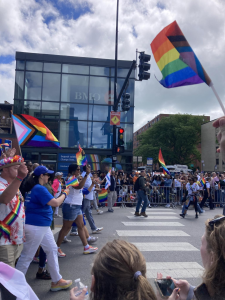Black Dahlia Pictures Should Not Have Been Printed
The beautiful aspiring actress’ murder remains unsolved.
February 16, 2015
Most people under the age of 25 have no idea of who Elizabeth Short was, or of the shockwave she sent across the country. If someone is 25 and knows of her, they know her better as the Black Dahlia.
Short was an aspiring actress in 1940s Los Angeles. She was stunningly beautiful, resembling a living porcelain doll, according to crimelibrary.com. On January 15, 1947, housewife Betty Bersinger was running errands with her 3-year-old daughter when she saw a white figure inches from the sidewalk. At first, Bersinger thought it was a broken mannequin from a store, but as she got closer she realized that it was the body of a young woman cut in half at her stomach – her insides were spilling out. This was the body of Elizabeth Short.
Short’s murder is the longest unsolved case in Los Angeles, and one of the most brutal and most famous cases in U.S. history. Short was not only cut in half; her face was violently mutilated. The killer had taken a knife and carved three-inch slashes into the corner of her mouth, resembling Heath Ledger’s Joker. Rope gashes were around her wrists and ankles.
Because of the nature of the crime, violent and vicious even by today’s standards, and because of Short’s beauty before her murder, the country and the press were obsessed, printing the pictures of Short’s body, while being tasteful and covering the majority of it with a blanket. However, as the internet has grown over the years, more graphic pictures of Short’s uncovered body have come around.
Recently, moviepilot.com posted an article about the case. The article reports that a retired LAPD police officer, Steve Hodel, believes his father is the killer. Hodel has only circumstantial evidence, such as reports of a woman’s screams coming from the alleged Black Dahlia crime scene. Hodel’s father also allegedly molested his daughter, had in his possession a photo of a woman who appears to be Short and fled the country to Asia soon after the murder.
Along with this article were many pictures. Two were headshots of Elizabeth Short, the first was the beautiful, “before” photo and the second was the gruesome, “after” photo. The “after” photo was of Short’s face from police evidence, with the grin sliced in her skin, dirt in her hair and on her face and what appeared to be bruises on her cheeks. This is unacceptable.
When I saw these pictures, I was disgusted, not by the images, but by the fact that someone was posting the images of this woman. This website has no respect for this woman by posting the hideous pictures of her mutilated body. There was no legitimate reason to post them other than to draw traffic to this website through the shock factor.
If this were a fictional photo from a film or television photo shoot, I would have kept my mouth shut and called it a day. The fact that for over 60 years, writers, filmmakers and gamers have been using the horrible death of this woman to make money is disgusting. Countless films, books and even a video game have been based around this crime, and have distorted the truth so much, that reality and fiction have blurred together and police are no closer to solving this case then when they took it in 1947.
Whether we like it or not the “Black Dahlia,” the moniker the Los Angeles Examiner gave her, is deeply rooted in our culture. Like the identities of the Zodiac Killer and Jack the Ripper, we may never know the killer.
Incidentally, stop romanticizing murders and giving them nicknames. They sell papers, but then we in turn idolize them. Do we really want to be a society that idolizes murders? But that’s an article for another day.






